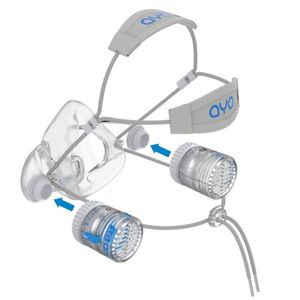Why Diaphragmatic Breathing?
The diaphragm is one of the main breathing muscles that should be used for our breathing by default. Diaphragmatic breathing training helps utilize the lower parts of the lungs that are more efficient to transport oxygen than chest (thoracic) breathing.
Efficient breathing helps better oxygen consumption by cells and tissues in the body, thus producing better sports performance as well as promoting better general health.
However, most modern people have predominant chest breathing where the lower parts of the lungs are less used, and as a result, breathing becomes inefficient, leading to less competitiveness in sports, or chronic hyperventilation in a lifetime that compromises people’s wellbeing.
In addition, diaphragmatic breathing can also achieve efficient lymphatic drainage of abdominal organs which is beneficial for your long-term health.

Here are some more general benefits this type of breathing can bring:
- It helps you relax, lowering the harmful effects of the stress hormone cortisol on your body.
- It lowers your heart rate.
- It helps lower your blood pressure.
- It helps you cope with the symptoms of post-traumatic stress disorder (PTSD).
- It improves your core muscle stability.
- It improves your body’s ability to tolerate intense exercise.
- It lowers your chances of injuring or wearing out your muscles.
- It slows your rate of breathing so that it expends less energy.
Mastering diaphragmatic breathing has a profound impact on your sports performance or your well-being in general.
Diaphragmatic Breathing Training with AYO BT in Jogging
While there are many ways to train for diaphragmatic breathing, most require dedicated time and focus to train properly. For many people with a busy lifestyle, it may be difficult to find time regularly for doing this specific training. Further, commonly recommended training for the diaphragm requires you to lie on the floor with a book on the belly, or in a still position placing your hand on the belly. The main issue with this type of training is a lack of linkage to real-life day-to-day activities, let alone physical exercises and sports training. The good news is that, with AYO BT, one can combine this breathing training with one of the routine exercises shared by many – jogging, either as a warm-up before a serious training section, or using jogging as a cross-training / general fitness exercise.
The goal of diaphragmatic breathing is to move your belly outward to make space for the diaphragm to go downward when you inhale, and to move the belly inward for the diaphragm to move upward to squeeze out the air at the bottom of the lungs when you exhale.
However, even with nasal breathing, one could cause hyperventilation during diaphragmatic breathing, especially when practising a full stroke of deep diaphragmatic muscle movement aggressively and repetitively which could result in breathing too much air that exceeds the need for metabolic rate the jogging exercise imposes on the body leading to over-breathing, thus compromising the benefits offered from the exercise.
In order to achieve the full benefits of diaphragmatic breathing training while at the same time avoiding hyperventilation, the key is to control the air intake according to the intensity of the exercise, and this is exactly what AYO BT is designed for.
Training with AYO BT in Default configuration – Inspiratory Focus
In the default configuration, where the BTi is fitted to the left side of the mask, and the BTo to the right side of the mask, the BTi can limit the air intake by adjusting the air inlet so that, the air is restricted thus increasing the resistance to breathe.
AYO BT in this configuration will focus on training and activating Inspiratory muscles.
When properly adjusted, the training will promote the following to your breathing:
- A slower and longer inhalation: if you try to breathe very hard, you wouldn’t get enough air as you would normally expect without wearing the respirator, and this is because the inhalation resistance through the small inlet at a high flow rate will be too big to breathe, thus leading you to breathe slower and longer.
- When you breathe slower and longer, you could easily breathe through your nose, and more importantly, your diaphragm is more engaged.
- When the air intake is reduced, depending on the exercise intensity and the BTi inlet setting, it can create some air hunger, so even if you perform a full stroke of diaphragm movements, hyperventilation can be avoided.

Diaphragmatic breathing Patterns
In comparison with Chest breathing, diaphragmatic breathing is generally slower and longer. However, it doesn’t mean that both inhalation and exhalation are equally slow and long, this is particularly true when doing certain breathing exercises.
The following training programs outline two of many possible options, and once mastered the techniques, you can make an adaptation to tailor to your specific needs and situations at ease.
Overtime with this training, you would expect the following distinctive benefits:
- Be able to use the diaphragm to breathe naturally.
- Stronger breathing muscles.
- Less breathlessness in high-intensity exercise.
- Improved breathing efficiency.
- Improved stamina and fitness.
Reference Diaphragmatic Breathing Training Program
| Diaphragmatic breathing pattern focusing on Inspiration timing: | Diaphragmatic breathing pattern focusing on Expiration timing: |
| 1. Use nasal breathing only during the entire exercise. | 1. Use nasal breathing only during the entire exercise. |
|
2. Adjust the BTi Setting to the level suitable for easy jogging and your current fitness. As a general guide:
|
2. Adjust the Inlet Setting 1 – 2 settings above the Inspiratory timing focused training.
|
|
3. Jog between 15 to 30 minutes.
|
3. Jog between 15 to 30 minutes.
|
